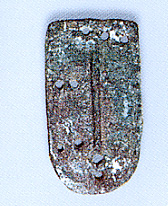 |
The Greek Age of Bronze
Scale Armour and War Belt |
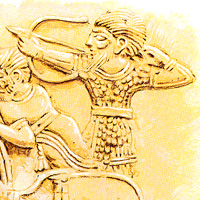 |
| The utilization of armour made of metallic scale by the Near Eastern warriors is well attested on iconography as well as for the presence of several findings. In the Aegean world this type of defence seems to be less common even if because of the intensive commercial trades the scale cuirass was well known by the Achaeans. Based on some findings and pictorial representations its utilization during the final phase of Late Helladic is reasonable both in Greece mainland than in the Achaean's settlements in the Anatolian coast and islands. |
| A bronze scale dated LH IIIC (about 1200 BC) dimension about 21 mm large and 51 mm long has been found in Mycenae. Even if the scholars believed that this element was part of an Oriental imported defence is indeed a proof that similar cuirass were well known and utilized in the Achaeans mainland.(*1) Similar example of bronze scale have been probably also found in Pylos and Crete, even if the interpretation as cuirass' scales for the two small metallic plates found in Phaistos is still questionable. |
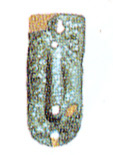 |
| Recently a very important discovery has been found in the excavation at the site of Kanakia, on the south-western tip of Salamina island. Together tools, Cypriot pottery and bronzes a single bronze scale from an armour breastplate was found. This remarkable element bears the stamp of the famous Egyptian pharaoh Ramesses II who ruled Egypt during the 13th Century BC. This is a possible evidence that Salamina warriors had fought as mercenaries in the army of Ramesses II. |
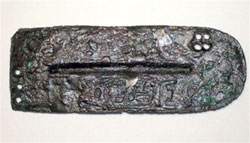 |
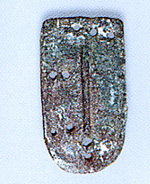 |
In the important Achaeans settlement of Cyprus together weapons, bronze objects and shield bosses, a bronze scale 61 mm long has also been found. This element dated LH IIIC is from Pyla-Kokkinokremos. |
| In a shipwreck excavation at Uluburun near Kas in the southern Turkey coast, a big bronze scale 30 mm large 90 mm long has been found. In this cargo ship dated about 1300 BC several Canaanite, Cypriote and Achaean manufactured goods have been found as well as raw material, weaponry and ceramics. |
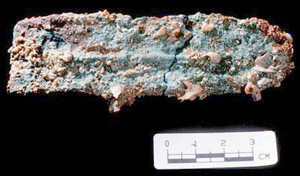 |
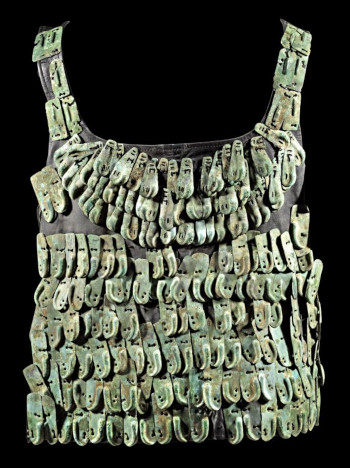 |
A large set of bronze scales have been declared found in Cyprus. These type of scales are probably dated from 1400-1300 BC |
| On pottery a possible representation of a scale armour is from this fragment from Tiryns dated LH IIIC. Of course because of the high stylization of the painting the scale armour hypothesis can only be based to the cross pattern design of this outfit which was different from the other ones represented in the same krater. |
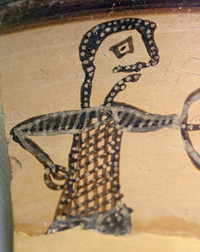 |
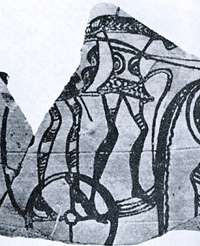 |
As already mentioned in page dedicated to the corselet, the defence represented in this krater fragment from Tiryns dated LH IIIC could be also interpreted as "Kiton" made of several layer of fabric, reinforced on upper and lower part with metal elements or scale. This could be a very primitive type of the "Linothorax" defensive equipment often reinforced by metal scale which was later used by the Hoplites during the Classical time period.
The charioteer is also equipped with a very large belt (*2) |
| Based on the Tiryns representation a possible reconstruction of a such linen defence with scale reinforcements on shoulders, torso, lower abdomen area and relevant belt can be thus assumed. |
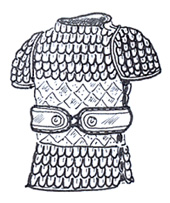 |
A very interesting pieces of what wery likely was an Aegean bronze war belt dated aroun 1300 BC has been found in the Anatolian settlement of Buyukkale near Bogazkoy.
The belt is composed by three layers the two external are in bronze while the middle one is made in silver. The layers are bended to each other on the edge. Inside the grooves of the external decorations gold threads are inserted.The decoration shows very close similarity with some attested in Mycenae and Crete. |
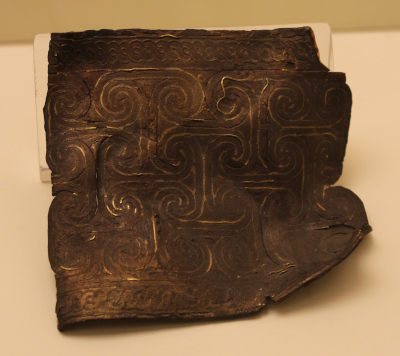 |
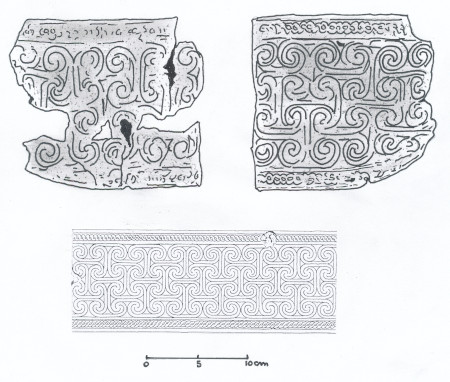 |
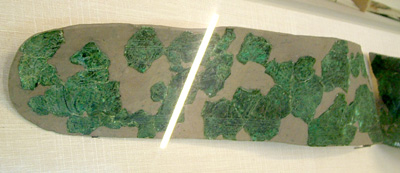 |
No other large belts from Achaean period have been so far discovered. Nevertheless a war belt has been found in Crete even if it is dated around IX century BC. |
| Another hypothesis about the "poncho" style corselet shows in the stele from Mycenae (see also the page edicated to the corselet) can be made. Because of its bronze like color this perishable material protection could also have been reinforced with metal strips as well as with some rows of scale similar to the one found in Mycenae. Based on these element a possible reconstruction of this defence could be reasonably assumed . |
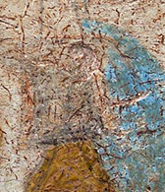 |
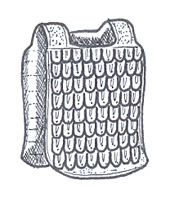 |
 |
The most clear representation of a scale armour from an area related with Achaean presence is from a ivory gaming box from tomb 58 in Enkomi Cyprus dated around twelfth century BC. The style of the figure drawing shows Aegean and Near Eastern influences. well represented are the as called "Feathers helmet" (see the pages dedicated to the late helmets and the sea people) and the waist belt. |
| On a Mycenaean pottery dated XIV-XIII Century BC found in Besiktepe in the Troad area a figure seems also wearing a possible scale corselet. |
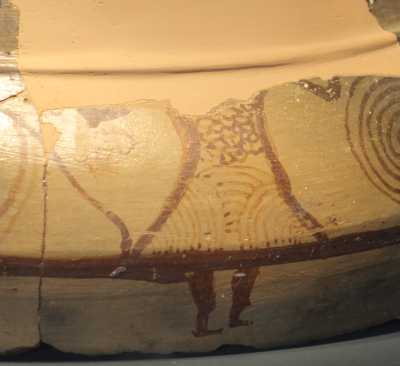 |
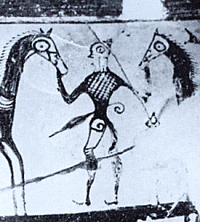 |
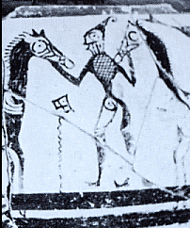 |
On a Mycenaean krater fragments from Ugarit Syria dated around 1200 BC some warriors with horses seems equipped with a short cuirass probably made of metal scale, neck protection, conical helmet, a belt or "mitra", greaves and a sword. Also in this case because of the artist stylization several hypothesis can be made, indeed the possibility of a scale cuirass is based on its narrow cross design,the general stiffness of the outfit, the presence of neck protection, and the geographical location of this pottery. furthermore a large quantity of bronze scale have been found in the same area (*3). |
Similar defence seems to be worn by the two warriors represented in a dish from the tomb 58 in Palaepaphos-Skales Cyprus dated around 1000 BC. The dish base is decorated with two warriors which seem to be equipped with short scale cuirass, neck protections, bow, spear and sword. The figures are trying to kill a large two-head snake, in the field are three quadrupeds and a flying bird.
No doubt this represent a mythological theme, recalling the Greek myth of the slaying of the snake of Lerna by Herakles and his companion Iolaos. |
| 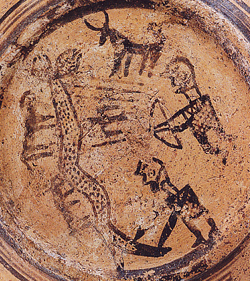 |
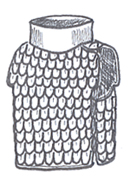 |
Based on the above representation a reconstruction of a short scale cuirass with neck protection can be reasonably assumed. |
|
| CONCLUSION
|
| In the late period of the Aegean Bronze Age some evidences of armour made of scale have been also attested in the Greece mainland even if it was less common than other typology of defence. The remarkable finding in Kanakia Salamina and in Uluburun shipwreck are a possible indication that these type of armour could have been normaly imported by the Near Eastern areas even if a Greece modest local production can't be excluded. Indeed based on several pottery representation and findings the best evidences of the utilization of such defence are from the Achaean settlements along the Anatolian coast and Syria as well as in the relevant Eastern Mediterranean islands like Cyprus in which the local cultures is clearly a mix between Aegean and Oriental elements.
|
| (*3) C.F.A. SCHAEFFER, Les fouilles de Ras Ahamra-Ugarit, Syria 18, 1973 p.144. |
|